Dec 17, 2010
Scott Sabol, Cleveland Fox 8 Meteorologist on -AO Impact
Scott Sabol, WJW Fox 8, Cleveland

Enlarged here.
Now that the AO has gone negative this month so far, I check the -AOs below -1 since 1950 and plotted the temperature anomoly for each year. Here is what I found.

Enlarged here.
Here is December through the 15th.
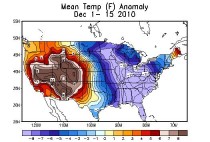
NE Ohio snow totals from last week from the Cleveland NWS. This week’s totals are similar.
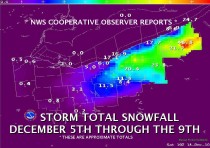
Enlarged here.
Thanks Scott!
Dec 17, 2010
Huhne: the final nail in the coffin of Cameron’s lousy Coalition?
By James Delingpole, UK Telegraph
Some things are beyond a joke and one of them is our energy secretary Chris Huhne “the Eco Loon”. Short of Osama Bin Laden as Minister of Transport, Caroline Lucas as Business Secretary, and Marcus Brigstocke as Minister for Comedy, it’s really quite hard to think of an appointment that could be less conducive to the welfare of Britain and her people.
But today, the Eco Loon has truly surpassed himself. Today is the day he attempts to persuade parliament that it is somehow in British interests to:
1. Destroy our economy.
2. Send our average annual utility bills soaring to around 2500 pounds per household.
3. Despoil our countryside.
4. Wipe out the free market.
5. Entrench the power of Big Government.
And in this, of course, he has the full support of the Eco Loon In Chief, prime minister David Cameron. In today’s Telegraph Huhne writes:
So on Thursday the Coalition begins a consultation on a reform that would reshape this market more fundamentally than at any time since the 1980s, when the Lawson reforms were the pioneer of Europe’s deregulation. Since then, we have acquired an overlay of instruments - notably the renewables obligation - that has provided a piecemeal response to the need for more secure, low-carbon electricity. By forging a comprehensive response, we can unlock investment in a broader range of low-carbon electricity generation. By providing greater certainty, we can encourage new market entrants and investors, reduce the cost of capital, and provide low-carbon electricity at lower cost than under present policies. Our mix of four inter-locking policies should give greater assurance of decarbonisation and lower bills.
What this achingly dull business-speak drivel means is that the Cameron administration intends to undo some of the fine work achieved by Margaret Thatcher. As Benny Peiser of the Global Warming Policy Foundation puts it:
Thatcher created Europe’s most competitive electricity and gas markets, privatizing state-owned businesses including British Gas, British Energy, National Power and PowerGen. By 1997, the change had driven down consumer prices by as much as 20 percent, compared with pre-privatization costs, according to former British Energy Plc Chief Executive Officer Robert Hawley.
Cameron - true Heir to Blair that he is - thus intends to offer us less choice, more constrained markets and higher prices. Nice one, Dave.
This would be a lot funnier, of course, if it weren’t so serious.
Part of Huhne’s plan calls for the creation of an artificial carbon market in which - following advice from the Committee on Climate Change - the government sets a CO2 floor price which will rise to 27 pounds a ton by 2020. If Britain lived in a bubble this might not be such a problem. Unfortunately the world markets do not believe that CO2 - aka volcano farts; aka plant food; aka Huhne’s breath - is worth anything like as much, or indeed that there is any prospect of it ever acquiring such value without the kind of global agreement which post- the Copenhagen and Cancun debacles is just never going to happen. Two years ago, C02 was trading on the Chicago exchange (CCX)at $7 a tonne. Earlier this year it was down to 7 cents a tonne. Then the exchange - founder investors: A Gore; Goldman Sachs; etc - stopped trading this worthless entity altogether.
In other words, what Chris Huhne and David Cameron are asking British business to accept is a swingeing impost which fines companies at 27 pounds a tonne for an (almost inescapable) by-product for which our global competitors are charged nothing at all. I don’t think any of us have much objection to Chris Huhne’s insatiable urge to be the first lemming over the cliff. What is of concern is the fact that currently he has been granted the power to drag us all over with him.
Every week, every day almost, I post in these pages about the economic and ecological disaster which awaits Britain if it goes ahead with Huhne’s and Cameron’s insane proposals to “decarbonise” the British economy at a cost conservatively estimated at 18 billion pounds a year. What depresses me almost as much as the sheer bloody uselessness of the Coalition is the bloody uselessness of my colleagues in the Fourth Estate (even the notionally “conservative” or free market ones) in opposing its wilder idiocies.
Huhne’s energy plans are absurd and destructive and wrong on so many levels it almost beggars belief that they are not regularly the butt of TV comedy sketches, outraged newspaper Op Eds and furious protests everywhere from the City to all those parts of the British countryside about to be ruined by Huhne’s 500 foot high bird choppers (aka Hoo Sticks). I shan’t rehearse them all again here. But just to show you how barmy the whole business is, here is Matt Ridley in the Times explaining why solar and wind power don’t even make sense on Huhne’s own terms of “energy security” and eco-friendliness:
For a glimpse of a truly scary future dependent on volatile suppliers look no farther than Mr Huhne’s favoured approach, the dash for wind. Every wind turbine has a magnet made of a metal called neodymium. There are 2.5 tonnes of it in each of the behemoths that have just gone up to spoil my view in Northumberland. The mining and refining of neodymium is so dirty (involving repeated boiling in acid, with radioactive thorium as a waste product), that only one country does it: China. This year it flexed its trade muscles and briefly stopped exporting neodymium from its inner Mongolian mines. How’s that for dangerous reliance on a volatile foreign supply?
Besides, wind does nothing to reduce carbon emissions. As Robert Bryce shows in his book Power Hungry, even Denmark, which can switch off imported Norwegian hydro power when the wind spins its many turbines, has failed to save any significant net carbon emissions through wind. The intermittent nature of the wind means that fossil-fuel power stations have to be kept going, or inefficiently powered up and down. Besides, the total power produced from even the biggest wind farms is so small that, as a strategy for reducing carbon emissions significantly, wind power is a failure.
Yes, gas has carbon in it, but half as much as coal for each unit of energy. So a dash for gas to replace coal would dramatically and rapidly reduce carbon emissions. Given Mr Huhne’s nuclear allergy, it is probably by far the most effective and low-cost way to do so. Solar is expensive (and strangely inefficient at night); tidal destroys ecosystems; wave is an engineering nightmare; there is no room for more hydro; and biofuels use just as much fossil fuel in their production as they produce in “green” fuel.
Shale gas has environmental risks - the water and chemicals used in the hydraulic “fracking” process must be safely disposed of - but environmental benefits too. Unlike renewables it is not land-hungry, taking up remarkably little space. A typical shale gas well has a footprint one 3,000th of the size of woodland producing the same amount of energy in firewood. Unlike coal and biofuels, it does not require transport by road and rail as it can be piped. Unlike oil, it cannot spill (and though it can explode, it rarely does). Unlike coal, its turbines work at small scale almost as efficiently as at large scale, so power stations can be many and local, supplying heat as well as electricity. It can be burnt near where people need power, requiring less investment in ugly pylons and transmission lines. Unlike coal it does not emit sulphur, mercury or other pollutants.
I can think of one consolation and one consolation only about the presence of a dangerous zealot like Chris Huhne in Cameron’s cabinet. Even more so than our useless justice minister Ken Clarke, his presence in government is such an affront to reason, so blatant an upraised middle finger to all those decent people who just want Britain to get back on its feet economically and begin undoing all the damage that was done to Britain by Cameron’s hero Tony Blair, that I suspect he may prove the undoing of the entire Coalition.
In Cameron’s cosy circle of spoiled toffs it of course matters not one jot whether your electricity bill is 250 or 2500 or, frankly, 25,000. It doesn’t matter if your view is ruined by a field of ruddy great wind turbines (not if say your father in law is Sir Reginald Sheffield who stands to make large sums of money from “farming” that intermittent wind). It doesn’t even seem to matter what happens to all those businesses, small ones especially, which are going to be crippled by these artificially-induced energy price increases: not when in Cameron’s circles the only people who really matter are either in-the-loop corporate fat cats whose larger companies can more easily wear the extra costs or City bankers heavily exposed to “green energy” interests.
To the rest of us, though, these things are going to start mattering more and more.
See post here.
Dec 14, 2010
Corporate Irresponsibility
Financial Post Staff
Deutsche Bank is putting its interest in making money off climate change ahead of the facts
By David Henderson
As the Cancun post-mortems continue, one area that calls for attention is the questionable role of leading businesses. Recent episodes involving the Deutsche Bank Group are illustrative of a wider problem. They give grounds for serious concern.
In September a report entitled “Climate Change: Addressing the Major Skeptic Arguments,” was issued under the auspices of Deutsche Bank. It was published by DB ClimateChange Advisors, a unit described on the bank’s website as “the brand name for the institutional climate-change investment division of Deutsche Asset Management, the asset-management arm of Deutsche Bank AG in the U.S.” The report was co-authored by three climate scientists at the Columbia Climate Center at the Earth Institute of Columbia University.
As the title suggests, the authors’ avowed purpose in preparing the report was to demonstrate that the “major skeptic arguments,” and any conclusions based on them, are to be rejected. To quote the document’s introduction: “This study aims to respond to the most common misconceptions that are presented to challenge the position that [greenhouse gas] emissions are adversely impacting Earth’s climate and will continue to do so.”
In an editorial preface to the report, the Deutsche Bank global head of climate-change investment research, Mark Fulton, describes it as “a balanced, detailed and expert assessment of the scientific case for climate change that will help investors navigate these extremely complex issues.”
The document’s claims to balance, and to accuracy as a navigational guide, were promptly put in question by the Canadian economist Ross McKitrick of Guelph University, one of the “skeptics” supposedly disposed of within it. Prof. McKitrick’s critique, entitled “Response to Misinformation from Deutsche Bank,” is dated Sept. 13. It focuses on two central topics treated in the report, with the main emphasis on the well-publicized “hockey stick” controversy. In relation to these topics, it identifies and spells out an extended list of errors, misrepresentations and falsehoods.
In response, the authors of the document have put out a revised text which replaces the original. But to create this new version they have simply inserted at the end a three-page “Response to McKitrick.” In these pages they admit to a few ‘mischaracterizations’ and offer amended versions of three sentences that they acknowledge to have been misleading. However, the original wording of these confessedly faulty sentences survives, unchanged and unfootnoted, in an unaltered main text. McKitrick has described this behaviour on the authors’ part as “unsporting.” Others might characterize it as unprofessional. The Deutsche Bank sponsors of the study should not have sanctioned it.
In a second set of comments, dated Nov. 8 and entitled “Response to Revised Report from Deutsche Bank,” McKitrick has extended and reinforced his critique. Up to now, there has been no further response from the authors of the report or from Deutsche Bank.
Viewed together, McKitrick’s twin presentations appear as damning and unanswerable. As a guide to investors, or indeed for any other purpose, this Deutsche Bank/Earth Institute report is worthless.
The report’s deficiencies put in question the conduct of its sponsors within Deutsche Bank, as also the conduct of those whom they report to. It would be interesting to know whether the officials who commissioned and approved this deeply flawed initiative took the precaution of submitting a draft for expert review to competent persons not already firmly convinced that “the skeptics” have been refuted.
Looking at the list of members, it would seem that no such person is to be found among the eminent individuals who make up the Deutsche Bank’s high-level Climate Advisory Board: All of these appear as people who are (to quote a nice phrase from Clive Crook) “pre-committed to the urgency of the climate cause.” They include the chair of the Intergovernmental Panel on Climate Change, Dr. R.K. Pachauri, and a former executive director of the United Nations Environment Program, Klaus Topfer.
It is not clear whether the Climate Advisory Board saw a draft of this Earth Institute report, or indeed whether they were aware that it had been commissioned. A more representative Advisory Board, spanning a wider range of opinions, might have taken more trouble to ensure that it was kept fully informed, and that any published work on climate change issues put out by Deutsche Bank would measure up to professional standards.
The Deutsche Bank Group has also taken its climate-change involvement into the political sphere. In the recent Californian elections, voters were invited to accept or reject Proposition 23, which would have placed strict constraints on the state government’s plans to introduce further curbs on carbon dioxide emissions. A few days before the vote, the Financial Times reported that “Sixty-eight big investors, managing US$415-billion in assets, have united to urge Californians to vote against efforts to roll back the state’s carbon legislation… Signatories include...Deutsche Bank Climate Advisers...”
It would thus appear that its Climate Change Advisors, who are no more than “the climate-change investment division of Deutsche Asset Management,’ took a strong position on behalf of Deutsche Bank on a controversial political matter. If so, it would be interesting to know whether and to what extent this action, which appears as questionable in itself, was authorized and approved at higher levels within the bank.
As its website confirms, Deutsche Bank is fully committed to the doctrine, now widely endorsed by businesses and governments, of Corporate Social Responsibility (CSR). How far its current handling of climate-change issues can be viewed as responsible is clearly open to doubt.
For any organization of standing, not least a leading multinational company such as Deutsche Bank, an obvious aspect of responsible conduct is a demonstrated concern for accuracy and the truth. The bank’s management board could now manifest such a concern, first, by commissioning an independent and informed review of this report, and second, by withdrawing and repudiating the report if the review supports McKitrick’s analysis.
In the wider context, however, Deutsche Bank is one of many, while the report shares its faults with numerous cousins. Both are symptomatic.
Businesses across the world, and governments too, have made unqualified and uncritical commitments to the view that in relation to climate-change issues “the science” is “settled.” Within the business world, as in the case of Deutsche Bank, endorsing this received opinion forms a leading aspect of CSR and, for many companies, of corporate strategy.
Received opinion largely rests on a belief, reinforced by statements from leading science academies, that in relation to climate science the official expert advisory process as a whole, and the IPCC assessment reports in particular, are to be seen as reliable guides.
Increasingly in recent years, arguments and evidence to the contrary have been presented by informed critics, prominent among whom have been McKitrick and his fellow Canadian, Stephen McIntyre. In my view, these critics have made a powerful case. The IPCC process has been exposed as being far from a model of rigour, inclusiveness and impartiality, while influential publications on climate-change issues have been shown to be professionally flawed.
Neither businesses nor governments have given the critics due attention. But in the past year or so, new developments have cast further doubt on the claims to objectivity and competence of the official expert advisory process and its official sponsors. In particular, the so-called “Climategate” and “Glaciergate” episodes have exposed attitudes and practices which were clearly unprofessional.
In response to these embarrassing revelations, Dr. Pachauri and the UN Secretary-General asked the InterAcademy Council, a creation of science academies around the world, to appoint an expert independent review committee to report on the process and procedures of the IPCC.
The resulting report was published at the end of August. Because of its careful and qualified wording, both sides of the climate-change debate have been able to draw encouragement from it. I see the report as making a major contribution in two respects: First, it made numerous recommendations for improving the IPCC process; and second, it stressed the need to ensure that a full range of informed views is taken into account, thus confirming that “the science” is not “settled.”
These twin conclusions are subversive of received opinion. Hence the report could help pave the way for significant improvements in the handling of climate-change issues.
The main focus of improvement is clear. In an area of policy where so much is at stake, and so much remains uncertain and unsettled, policies should be evolutionary and adaptive, rather than presumptive as they are now; and their evolution should be linked to a process of inquiry and review that is more thorough, balanced, open and objective than has so far been the case.
Whether and how far a more judicious approach on these lines will gather momentum depends principally on governments, but businesses and business organizations could play a useful - and more responsible - part in raising the quality of debate. As the current example of Deutsche Bank confirms, there is a long way to go.
David Henderson was formerly head of the Economics and Statistics Department of the OECD. He is currently chairman of the Academic Advisory Council of the London-based Global Warming Policy Foundation. His latest publication on climate-change issues has just appeared in the quarterly Newsletter of the Royal Economic Society.
See also Financial Post’s Bank part of global corporate craze to cash in here. They conclude: “As Mr. Henderson puts it, the Deutsche report on climate skeptics has been rendered worthless as a guide to the science and for investors. It also betrays a larger issue, which is a corporate role on the part of Deutsche Bank that makes Exxon look like a Boy Scout.” Icecap note; it should be remembered that Lehman put together a detailed two volume report on climate change as a prospectus for the huge profits they would make in carbon trading and green investments. Like Deutsche bank, they used sources equally willing to prostitute themselves for the cause and dollars. It the process, they took their eyes off the ball of their business and incurred huge loses when the bubble burst and are no longer in business.
Dec 13, 2010
Forty Years of Drama Queen Scientists
By Donna Laframboise, Nofrakkingconsensus
We are routinely urged to heed climate scientists who say the world is in peril and that humanity must mend its environmentally damaging ways. What we’re rarely told is that these scientists are part of a long tradition.
Four decades ago, in January 1972, the Ecologist magazine published a lengthy essay titled A Blueprint for Survival. Shortly afterward, the essay was re-packaged as a 140-page best-selling paperback. As the back cover of my edition explains, the book:
...offers radical proposals for immediate action...The Blueprint is supported by 34 distinguished biologists, ecologists, doctors and economists...[bold added, see list of names here and here]
On the front, in large type, is a quote from the Sunday Times:
Nightmarishly convincing...after reading it nothing seems quite the same any more.
Forty years ago, therefore, environmentalists, experts, and journalists were doing exactly what they do now. Brandishing impressive credentials, they were scolding us about our lifestyles and threatening dire consequences if their pessimistic pronouncements were ignored.
It is the proper role of scientists to collect and interpret data. They can then present their findings regarding what effect they believe we are having on the environment. But the question of how society should respond to their findings is a political matter. It involves debate and a careful weighing of competing approaches and interests. The decision must be made by those elected to govern us. This is because elected officials are accountable. If they introduce policies the public considers intolerable they’ll lose their jobs.
The 34 distinguished biologists, ecologists, doctors, and economists who endorsed the Blueprint are accountable to no one. If such people started making decisions regarding economics, public health, transportation, and other matters we’d be exchanging representative democracy for tyranny on the part of these select experts. We’d be saying that a small number of people know better than we do what is best for us and our children.
I think that’s bunk. I also think it’s important to note that some experts are drama queens. For them, the glass is always half empty and everything is always a crisis (rather than a manageable problem). Unfortunately, drama queens tend to attract media attention. We therefore need to start noticing that, no matter what the specific problem has been, drama queen scientists have been pushing the same unpalatable solutions for 40 years: fewer humans, less consumption, less travel - and less freedom.
Let’s take a peek inside 1972’s Blueprint. According to the preface:
(1) “We should be concerned by “the extreme gravity of the global situation”
(2) “If current trends persist “the irreversible disruption of the life-support systems on this planet, possibly by the end of the [20th] century, certainly with the lifetimes of our children, are inevitable."”
(3) “Governments are refusing to face facts and therefore are failing to undertake necessary “corrective measures”
(4) “A self-appointed group of “scientists and industrialists...is currently trying to persuade governments, industrial leaders and trade unions throughout the world to face these facts and to take appropriate action while there is yet time.”
(5) “A new political movement is necessary; this movement must embrace “a new philosophy of life, whose goals can be achieved without destroying the environment”
It doesn’t get much clearer than that. Forty years ago some scientists used their respected place in society to advocate for a new political movement, a new philosophy of life. While scientists are entitled to their views, their expertise is not in political philosophy. This means their opinions regarding how the world should function deserve no more consideration than the opinions of a random nurse or taxi driver.
What else were they saying back in 1972? The first line of the Blueprint‘s introduction declares that an industrial way of life is “not sustainable.” We’re told humans are consuming too much, polluting too much, and having too many babies. We’re told economic growth is the enemy and that austerity is the answer. We’re warned that unless things change radically “a succession of famines, epidemics, social crises and wars” are inevitable.
Let’s think about that last point for a moment. For decades, people have wanted us to urgently and radically change our ways. Why? Because, in their opinion, bad things will happen if we don’t.
I’m happy to take my chances with the future, thanks. The past 40 years bear little resemblance to the horror story the drama queens were predicting back in 1972. Average people are now richer and healthier. They live longer lives and many enjoy access to more food, culture, and technology than did the princes of old. In much of the world the air and water is cleaner than it was in the 1970s, and the forests are larger. As books such as Matt Ridley’s Rational Optimist patiently explain, the planet is not headed to hell in a handcart. Things are far from perfect, but the current situation looks nothing like the collapse predicted by the Blueprint 40 years ago.
My personal view is that the future is going to be even better. I see human history as a narrative in which ever more people rise out of poverty, in which we become increasingly smarter about resource management, and in which game-changing ideas are merely a discovery away.
My version of the future is surely as likely to come true as is the drama queens’ version. It’s difficult to overstate this point. These gloomy people think we should all change our behaviour because they are incapable of seeing anything but catastrophe on the horizon. They think their guesswork about the future gives them the right to tell the rest of us how to live.
The Blueprint calls for the establishment of a “national population service.” One of its mandates would be to research “the subtle cultural controls” that would ensure people have fewer children. It calls for taxes on energy as well as on raw materials. It demands the “end of road building” and “restrictions on private transport.” The following passage provides a sample of the moralistic, utopian tone of this book:
...people use their cars for four main reasons; to go to work, to go to the countryside, to visit friends and relations, and to show off. In the stable [eco friendly] society, however, each community will provide its own jobs, there will be countryside around it, most friends and relations will be within it, and there will be much more reliable and satisfying ways of showing off.
Not only does the Blueprint envision redesigning society from top to bottom, it imagines that it’s possible to alter human nature - to orchestrate via bureaucratic fiat how, precisely, people will choose to show off. As any parent of a young man with a fetish for fast automobiles can tell you, such things are easier said than done.
When I read the Blueprint I’m reminded of Soviet Communist Party literature prior to the fall of the Berlin Wall. The Communists also thought they were building a better world. They thought they could alter human nature and that, if they only planned carefully enough, a prosperous and harmonious society would transpire. Communist party publications, I might add, were characterized by the same pompous, judgmental tone.
The Communist reality, however, was a disaster. Which means that before I’m willing to place my trust in anyone else’s utopian fantasies they’ll need to spend an awful lot of time explaining what they’ve learned not to do based on their careful study of the Soviet and Chinese debacles. Quick tip: let’s start with how many independent safeguards will ensure that millions of souls cannot be starved or murdered by their own government.
Drama queens inhabit a fear-filled world - one that’s dangerously unpredictable and in which some small matter can trigger the apocalypse. They have little faith in their own ability to cope, in humanity, or in the future. No matter how many good things have happened, they insist on identifying the flaw in every apple. They are a personality type - and they are a part of our collective humanity.
But a world that permits that part of us to determine the future is a world in which the future may, indeed, turn out to be bleak. See post and much more on Donna’s website here.
H/T Marc Morano.
Dec 10, 2010
Snow Season Off to a Roaring Start
By Joseph D’Aleo, CCM
Last year the Northern Hemispheric snowcover was the second highest in the NOAA snow history back to the mid 1960s. It trailed only the legendary 1977/78 winter. It fell just ahead of 2007/08, pushing it to third place. The winter of 2002/03 dropped to fourth place and the bitter winter of 1978/79 fifth.
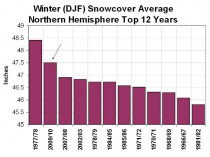
Average winter snowfall anomalies for the top 12 snowiest winters - source Rutgers/NOAA. Enlarged here.
All through last winter the snowfall was above normal from the end of the first week of December through the third week of March.
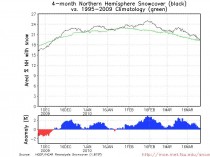
Snow anomalies for the Northern Hemisphere for 2009/10 - source Hart FSU. Enlarged here.
The heavy snows in Europe and Asia and now beginning in North America have this year off to a good start again. See 33 stories of the cold start in the UK beginning with Snovember here.
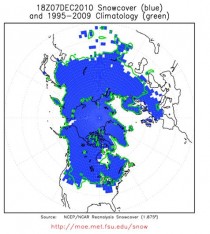
Snow anomalies for the Northern Hemisphere - source Hart FSU. Enlarged here.
You can see the recent snow has the hemispheric snowcover above normal a few weeks earlier than last year.

Snow anomalies for the Northern Hemisphere this year through December 7, 2010 - source Hart FSU. Enlarged here.
The pattern will continue cold across the western parts of Canada, much of United States and across Eurasia. A strong blocking high pressure will push back from the North Atlantic to the Davis Straits. Snow will be heavy along the edges of the cold air and near the unfrozen Great Lakes where many feet will accumulate. More bitter arctic air - perhaps coldest since 1894 is forecast for the UK.
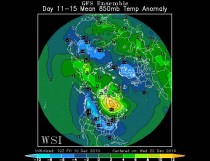
850 mb temperature anomalies (Degrees C) for the 11 to 15 day period centered on December 22, 2010. Enlarged here.
Looks like a White Christmas in many areas much like last year.

Enlarged here.
See PDF here. White Christmas forecast coming.
|












